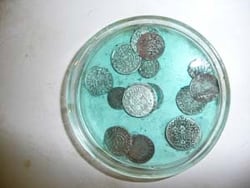




16 Aug 2007 Jug with silverware under the church floor
Categories: Minting - Numismatics , Finds and rescue research in the Czech Republic , Calendar
 In eastern Slovakia, workers dug up a clay jug full of silver coins. It was under the floor of an unassuming church in the town of Žalobín in eastern Slovakia. The finders immediately handed the treasure over to the local parish priest.
In eastern Slovakia, workers dug up a clay jug full of silver coins. It was under the floor of an unassuming church in the town of Žalobín in eastern Slovakia. The finders immediately handed the treasure over to the local parish priest.
"We found the jug. There were round dirty objects in it. I thought they were some slot machine chips or something. After cleaning it, we found that we had discovered coins," said treasure finder Jozef Steger.
Someone probably saved the coins for a rainy day sometime in the sixteenth or seventeenth century and couldn't come back for them. The coins were examined by experts from the Homeland Museum in Hanušovce nad Topľou.
"The oldest one dates back to 1561. The parish priest did not keep the entire collection for himself, but had it examined at the local museum of patrimony. Experts confirmed that the jug contained mainly Polish groszy and Hungarian denarii from the time of the anti-Habsburg uprisings," said Mária Jenčová on behalf of the museum.
The silver coins from the earthenware jug belong to the church in Zěšín. If he decided to sell the treasure, however, he wouldn't make much money. The depot contained mostly Polish and Hungarian coins of little value.
Žalobín is a small village in the Vranov nad Topľou district with a population of less than a thousand. The oldest traces of settlement in the area date back to the fifth century BC. At the end of the third century BC, prehistoric shepherds moved there. The greatest expansion took place during the Great Moravian period.
The local church of St. Francis of Assisi was rebuilt in 1765 using an older sacred building dating from the sixteenth or seventeenth century. It was rebuilt after the earthquake of 1778.
After the Second World War, the building was restored. The interior features Renaissance cross vaults and a Baroque sacristy. The pulpit with rococo ornaments dates from the eighteenth century. Other furnishings date from the twentieth century. The current state of the church is good and mass is held there regularly.
Sources: www.ceskatelevize.cz, www.pamiatkynaslovensku.sk, www.sme.sk
The article is included in categories:






